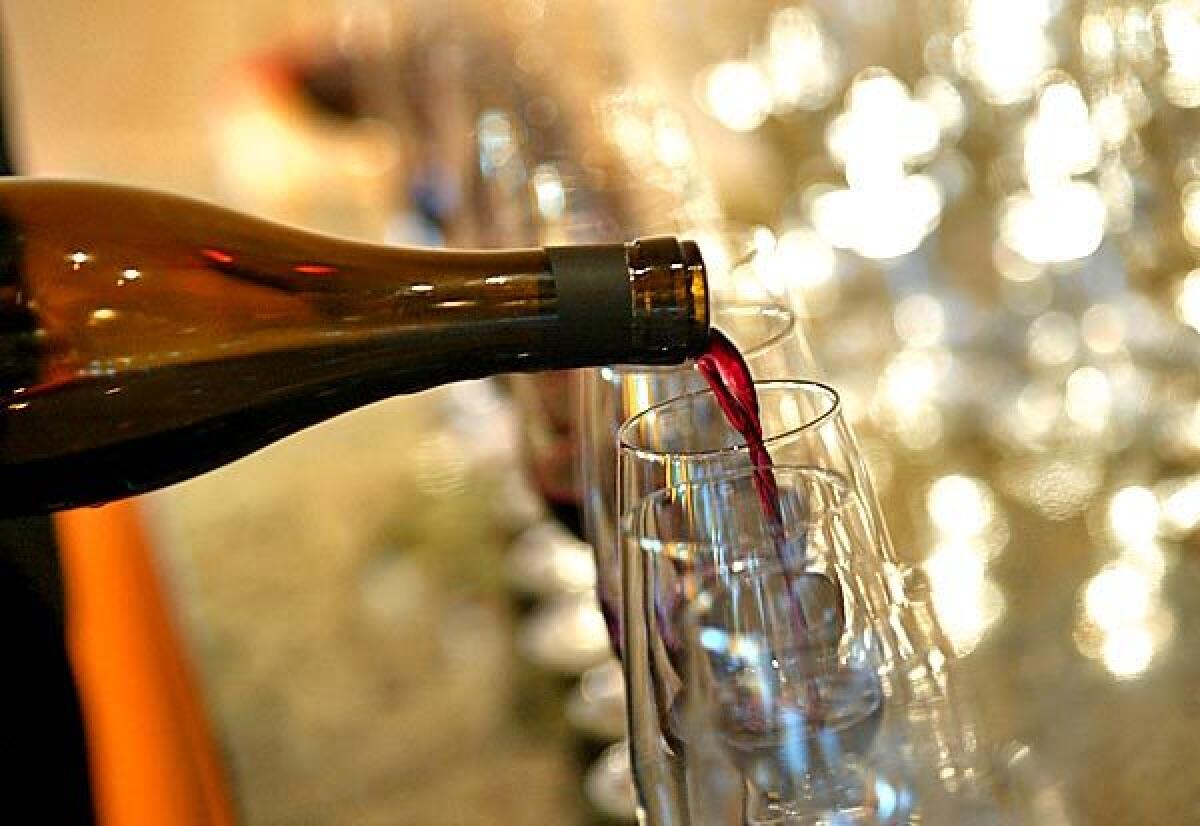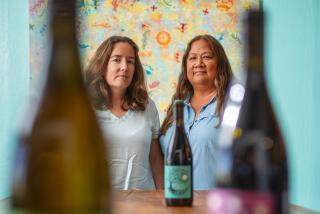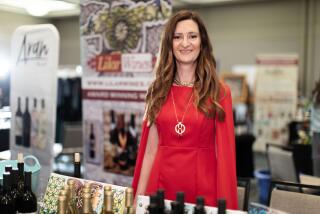Wild yeast, natural wine

“Natural wine” is the trendiest term to be punted about by people seeking something nongeneric. It’s also the vaguest, and that’s a mixed blessing.
In San Francisco, a loose coalition of wine bars and shop owners is trying to define natural wine based not on grapes but on yeast. This leads to a wide range of natural wines from around the world, often with unusual, nonfruit flavors. The trend isn’t yet as strong in Southern California, but the ground is fertile -- the move toward more, well, natural winemaking is popular here too.
“Lots of people come in and ask for organically farmed wines, or wines with no sulfites,” says Thomas Rekasis, food and beverage manager for Viceroy Santa Monica hotel. Rekasis says nobody has yet asked about yeast, but it may be a matter of time.
So why natural wine, and why yeast? Because the other well-meaning terms in use -- “biodynamic,” “sustainable” and “organic” -- come with flaws of their own and say more about farming than winemaking.
Here’s a quick primer.
Biodynamic agriculture follows the work of Austrian philosopher Rudolf Steiner, who believed in looking at a farm as a holistic organism. It involves many Earth-friendly techniques, but at its core it’s an unproven spiritual practice with planting, harvesting and bottling timed by the phases of the moon.
Sustainable viticulture looks at the big picture, including a winery’s social and environmental impacts. Advocates argue that by definition it’s the best long-term program, but because it takes economic sustainability into account, it says the least about what methods can be used to produce any one particular bottle of wine.
Organic is the most loaded term of all. The U.S. government has official definitions for both “organically grown grapes” and “organic wine.” To use either, a winery must pay an annual certification fee, a significant expense for small wineries.
I’m a big fan of organically grown grapes but not organic wine, which in the U.S. must have no added sulfites, meaning it probably won’t last long in your cellar before its fresh fruit flavors disappear. But sulfites are a naturally occurring and necessary component of wine production, so the European Union, generally more strict on wine regulations, allows added sulfites for wines labeled as organic. (If you think sulfites give you red-wine headaches, be advised that white wines, as well as dried fruit, generally have much higher levels of sulfites than red wines.)
Now here’s “natural”: For purists, it requires organic, biodynamic or sustainable grape growing, and wild yeast fermentation. In theory, it’s a step above the others. But there’s no official definition, so in practice, it could mean anything at all.
“We’re coming to an agreement on what natural wine means, and the one thing we all agree on is native fermentation -- the yeast comes from the grapes,” says Ian Becker, lead wine buyer for Absinthe restaurant and Arlequin Wine Merchant in San Francisco. “We all agree that using nonnative yeast, that’s unnatural.”
I think all the terms (save organic wine) have merit, and I give extra credit to a wine that qualifies for any of them. But Becker is a zealot: He tries to carry only natural wines at Arlequin and says he would reject a wine that was biodynamically or organically farmed but did not use native yeast.
“People use commercial yeasts to stay on schedule, to keep a business plan,” he says. “If you’re making wine to make money, you’ll use commercial yeast. If you’re making wine because you love it, you’ll use native yeast.”
Yeasts vary wildly
In a nutshell, here’s how wine is made: Grapes are harvested and crushed to release their juice. Yeasts, which are in the air all around us, convert sugar in the grapes into alcohol. Then they die and slowly fall to the bottom of the tank or barrel, to be removed before bottling.
Different yeasts have different characteristics. Some can tolerate high alcohol levels; this is an important reason why wines are ever more potent. Some commercial yeasts, added in a simple, descriptive process called inoculation, are even chosen for flavors they impart.
In contrast, wild yeasts are a gamble. They might die before all the sugar has converted, leaving a sweet wine. Or, in the worst circumstance, they might impart off flavors. This is why most large wineries shun using them -- because they’re risky.
But one man’s off flavor is another man’s exotic. Fans of natural wines say that if wild yeasts are part of the vineyard, then their flavors are part of the wine.
“We’re conditioned to find funkiness a flaw,” says Lou Amdur, owner of the Hollywood wine bar Lou. “But at a low level, I kind of enjoy it. I prefer wild yeasts, and I think I can tell them in a blind tasting. Just because you’re farming organically or biodynamically doesn’t mean you’re making a natural wine or an interesting wine. There are any number of wines that are farmed in a beautiful way, but they get in the winery and they’re made in a very cookie-cutter way.”
French birthplace
The idea for natural wines started in France. Jules Chauvet, a négociant from Beaujolais who died in 1989, is considered the father of the concept, and more wines considered natural today are from France than anywhere else.
But there are American wineries making natural wines, and some are excellent.
Tracey Brandt, co-owner of Donkey & Goat winery in Berkeley, is proud of being the only American winery chosen to appear at a natural wine event in November in Stockholm.
“We consider natural wines to have only natural yeasts and only be fermented in natural materials -- no stainless steel,” Brandt says. “We’re not religious. We just think this makes the best wine.”
Her 2007 Donkey & Goat Syrah from Perli Vineyards in Mendocino Ridge ($35) is an example of how complex a natural wine can be. It’s like a meal in itself, with flavors of black pepper, raspberry, grilled lamb and pink peppercorns. It has interesting floral notes in the aroma and just the right firmness of mouth feel.
Another fine natural California winery is Lioco, founded by wine importer Matt Licklider and Kevin O’Connor, former wine director at Spago Beverly Hills. Lioco uses only wild yeast but defines natural wine differently from Donkey & Goat -- for example, all its Chardonnays are fermented in stainless steel tanks. The results are downright funky; I smelled durian and turkey meat, along with lime and chalk, in the 2006 Lioco Chardonnay from Michaud Vineyard in the Chalone region ($40), and I don’t know if I liked it or not.
On the other hand, I adored the 2007 Lioco “Indica” Mendocino County Red Wine ($20), which is 78% old-vine, organically grown, dry-farmed Carignane from the Redwood Valley vineyard of Alvin Tollini, whose grandfather left him the vineyard only after he promised not to rip out the Carignane (a temptation because other grapes sell for more). That’s a great story and it’s a fine wine, Pinot Noir-like with its bright raspberry fruit, spicy nose and light body. But it includes 9% Mourvedre and 3% Grenache from Russian River Valley, so it can’t be said to have a sense of place.
That’s the problem with natural wine as a term: Its vagueness makes it as flawed as all the others, and if it gets popular enough, it might be the easiest to co-opt. Unless, of course, it really is all about the yeast.
“Drinking wine is a symbolically loaded act,” says Amdur, arguing for natural yeasts. “I’ve been doing a lot of thinking in the last year about how do we make more interesting wines happen. People get bored hearing me talk about yeast so much, but we need to support nascent natural wines in California.”
Ironically, though, when it came to making a decision about which yeast to use in his own homemade wine this summer, Amdur ultimately opted for commercial yeast because, he says, “I didn’t want to screw it up.”
More to Read
Eat your way across L.A.
Get our weekly Tasting Notes newsletter for reviews, news and more.
You may occasionally receive promotional content from the Los Angeles Times.









